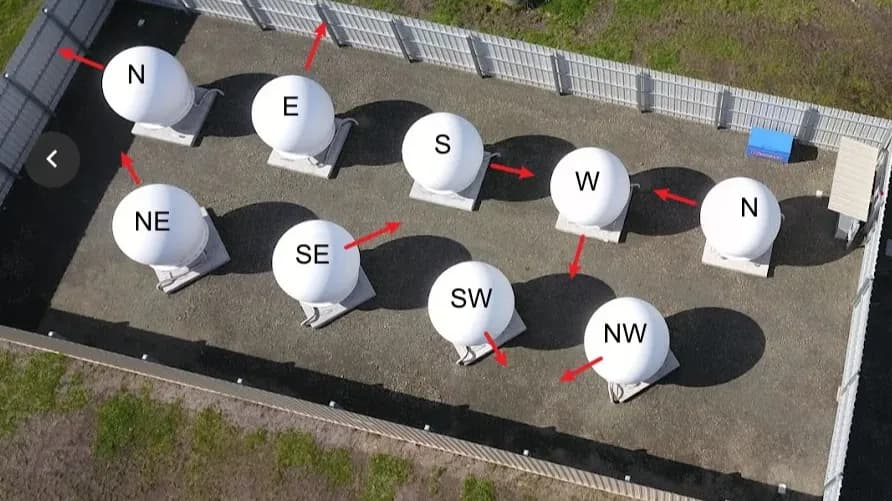Starlink Ground Stations: What They Are and How They Work
Stella Linkson

What Are Starlink Ground Stations?
A Starlink ground station is a data center on Earth that sends and receives signals to and from Starlink satellites. These stations connect the satellites to the global internet. When you send a request from your computer, it goes from your dish to a satellite, which then sends it down to a ground station.
Here’s the breakdown. The ground station connects to the internet's backbone with high-speed fiber optic cables. This physical connection gives the Starlink network access to the web. Without these stations, the satellite service would not work.
The Link Between Satellites and the Internet
Satellites in the Starlink group are always moving. A single satellite is only in view of your dish for a few minutes. The network hands off your connection from one satellite to the next as they pass.
Each satellite must also be in contact with a ground station to send and receive data. The network of ground stations gives each satellite a clear line of sight to a facility on the ground. This constant contact provides a stable connection for users.
Gateways and Earth Stations
You might hear a SpaceX ground station called by a few different names. These terms often refer to the same thing.
Gateway: This is Starlink's technical term. It shows that the station is a "gateway" between the satellite network and the internet on the ground.
Earth Station: This is a general term from regulators like the Federal Communications Commission (FCC) for any station on Earth that communicates with spacecraft.
How Starlink Ground Stations Work
A Starlink ground station's job requires precision engineering. The process is a high-speed, continuous loop of data transmission that happens in milliseconds.
Let’s look at the steps. When you open a website, your request follows this path:
User Dish to Satellite: Your personal Starlink dish sends the request up to a satellite passing overhead. It uses Ka-band or Ku-band radio frequencies.
Satellite to Ground Station: The satellite receives your request and immediately sends it down to the nearest available ground station.
Ground Station to Internet: The ground station gets the data through its large antennas. It then sends your request to its destination server through a fiber optic connection to an Internet Exchange Point (IXP).
The website's response travels back through the fiber network to the ground station, which beams it up to the satellite. The satellite then sends it down to your dish. This entire round trip happens fast enough for activities like video calls and online gaming.
The Technology Inside
Each ground station holds an array of antennas. In most locations, these antennas are inside large, white, golf ball-like domes called radomes. The radome protects the antenna from weather like rain, snow, and wind without blocking radio signals. A station usually has several radomes, each tracking a different satellite. This setup maintains a persistent connection as the satellites move.
Starlink Ground Station Locations
SpaceX has been building its network of ground stations around the world to support its subscribers. The locations are chosen to provide good coverage and performance for users in a region.
Where Are Starlink's Ground Stations?
Starlink ground stations are placed in areas with strong fiber internet connections. This is because each station needs a reliable, high-bandwidth link to the internet backbone. Many are in rural or semi-rural areas with available land and little radio frequency interference. Public data from FCC applications shows where many of these stations are in the United States. The network is growing as Starlink gets licenses to operate in new countries.
(Source: Application for Earth Station Authorization, File No. SES-ASG-20200526-00639, Federal Communications Commission, May 26, 2020, fcc.report/IBFS/SES-ASG-20200526-00639)
Why This Placement?
The location of a Starlink ground station depends on a few things:
Proximity to Fiber: The station must be close to a major fiber optic line to lower latency and support high speeds.
User Density: More stations are required in regions with more Starlink users to handle the data load.
Geographic Coverage: Stations must be spread out so that satellites always have a gateway in their line of sight.
Regulatory Approval: SpaceX must get permission from national regulators, like the FCC in the USA, to build and operate a ground station.
How Many Starlink Ground Stations Exist?
The number of Starlink ground stations changes as SpaceX builds new ones. As of late 2025, there are likely more than 150 active ground stations globally, with more being planned or built.
A Growing Network
SpaceX files applications with regulators for new ground stations often. This growth helps expand service to new areas and increases the network's capacity in current markets. As the number of users and satellites grows, the ground network must also grow. Analysts track FCC filings and international regulatory databases to maintain a current count of Starlink gateways. These public documents give a very clear picture of the network's scale.
Frequently Asked Questions (FAQs)
Here are answers to some common questions about the ground part of the Starlink network.
What does a ground station for Starlink look like?
A Starlink ground station is usually a secure compound with several white radomes. Each radome is a large, round structure that can be up to 15 feet across. Inside each radome is a steerable dish antenna. The site also has support equipment for power and cooling.
Can you build your own Starlink ground station?
No, you cannot build your own ground station for the Starlink network. The ground stations are complex and proprietary infrastructure built and operated only by SpaceX. They require regulatory licenses and direct connections to fiber backbones that are not open to the public.
What is the cost of a Starlink ground station?
SpaceX does not release the cost of its ground stations. Industry experts guess that each station could cost between $500,000 and several million dollars to build. This price includes the antennas, radomes, networking hardware, security, and the high-speed fiber connection.
How are these stations powered and connected?
Each ground station needs a stable electricity supply. They connect to the local power grid and many have backup generators or battery systems. For data, they connect to the internet through contracts with major fiber providers like Google. These connections provide the capacity needed to serve thousands of users.
(Source: Powering Starlink: SpaceX’s satellite internet service is using Google Cloud, Google Cloud Blog, May 13, 2021, cloud.google.com/blog/products/infrastructure/spacex-starlink-and-google-cloud)
The Future of Starlink's Ground Network
The design of the Starlink network is always being updated. Future developments may change the role and number of ground stations.
Inter-Satellite Lasers
A new feature for the Starlink group is the addition of inter-satellite laser links. These lasers let the satellites pass data directly to each other in space, creating a mesh network in orbit. This technology means not every satellite needs to be in direct contact with a ground station at all times.
For example, a user's signal could go up to one satellite, bounce across several others using lasers, and then come down to a ground station thousands of miles away. This is very useful for providing service over oceans and in very remote areas. While this makes the network less dependent on ground stations, it does not remove the need for them. They will always be the final link to the internet.
Expansion into More Regions
As Starlink expands its global coverage, SpaceX will continue to build ground stations in new countries and remote locations. The growing network of ground stations shows the scale of the engineering work behind this global internet service.
Current Status and Locations
As of October 2025, Starlink operates approximately 150 ground stations globally, with an additional 13 under construction and 19 pending construction. These stations are strategically distributed across various regions to ensure comprehensive coverage:
Continent | Country | State/Territory/Region | Location(s) |
North America | United States | Alaska | Fairbanks, Ketchikan, Kuparuk, Nome, Unalaska |
Arizona | Roll | ||
California | Arvin, Hawthorne, Murrieta, Robbins, Tionesta | ||
Colorado | Elbert | ||
Connecticut | Litchfield | ||
Florida | Fort Lauderdale, Kenansville, Punta Gorda | ||
Georgia | Atlanta, Baxley, Norcross | ||
Hawaii | Molokai | ||
Idaho | Colburn | ||
Illinois | Broadview, Clinton, Sheffield | ||
Indiana | Mt Ayr | ||
Iowa | Des Moines | ||
Kansas | Inman, Lawrence | ||
Maine | Brunswick, Loring, Sullivan | ||
Maryland | Frederick, Elkton | ||
Michigan | Hillman, Manistique | ||
Minnesota | Hitterdal, Marcell | ||
Missouri | Warren | ||
Montana | Butte, Conrad | ||
Nebraska | Benkelman, Nemaha | ||
Nevada | Panaca | ||
New York | Beekmantown, Lockport, Romulus | ||
North Carolina | Mandale, Wise | ||
North Dakota | Cass County, Rolette, Slope County | ||
Ohio | Columbus | ||
Oklahoma | Savanna, Springer | ||
Oregon | Charleston, The Dalles | ||
Pennsylvania | Greenville, Port Matilda, York | ||
South Carolina | Charleston, Gaffney | ||
Tennessee | Savannah, Tracy City | ||
Texas | Boca Chica, Dumas, Hamshire, Hillsboro, Marshall, McGregor, New Braunfels, Richardson, San Antonio, Sanderson, Wichita Falls | ||
Utah | Vernon | ||
Vermont | Lunenberg | ||
Virginia | Boydton | ||
Washington | Bellingham, Brewster, Kalama, North Bend, Olympia, Prosser, Quincy, Redmond | ||
Wisconsin | Merrillan, Roberts | ||
Wyoming | Cheyenne, Evanston | ||
Puerto Rico | Ponce, Toa Baja | ||
Canada | Ontario, Quebec, Nova Scotia, Newfoundland | Marathon, Saguenay, Sambro Creek, St. Johns | |
Mexico | Various States | Cabo San Lucas, Charcas, El Marques, Llano Grande, Mazahua, Merida, Monterey, Peñuelas, Tapachula, Villahermosa | |
Europe | France | Nouvelle-Aquitaine | Villenave d'Ornon |
Germany | Lower Saxony, Hesse | Aerzen, Frankfurt, Usingen | |
Ireland | County Cork | Ballinspittle, Elfordstown | |
Italy | Puglia, Sicily, Lombardy | Foggia, Marsala, Milano | |
Lithuania | Kaunas County | Kaunas | |
Norway | Troms og Finnmark | Tromsø | |
Poland | Masovian Voivodeship | Wola Krobowska | |
Spain | Valencian Community, Andalusia, Community of Madrid | Ibi, Lepe, Villarejo de Salvanes | |
United Kingdom | England, Isle of Man | Chalfont Grove, Fawley, Goonhilly, Hoo, Isle of Man, Morn Hill, Wherstead, Woodwalton | |
South America | Brazil | Various States | Camaçari, Guarapari, Itaboraí, João Câmara, Luz, Manaus, Montes Carlos, Mossoró, Passa Quatro, Porto Alegre, Presidente Prudente, Rio Negro, Surubim, Uruguaiana |
Chile | Atacama, Santiago, Los Lagos, Araucanía, Magallanes, Maule | Caldera, Noviciado, Puerto Montt, Puerto Saavedra, Punta Arenas, San Clemente, Santa Elena | |
Oceania | Australia | New South Wales, Western Australia, Victoria, Queensland, South Australia | Boorowa, Broken Hill, Bulla Bulling, Calrossie, Canyonleigh, Cataby, Cobargo, Ki Ki, Merredin, Pimba, Springbrook Creek, Tea Gardens, Toonpan, Torrumbarry, Wagin, Warra |
Asia | Japan | Akita, Ibaraki, Hokkaido, Yamaguchi | Akita, Hitachinaka, Otaru, Yamaguchi |
Philippines | Cebu | Poro | |
Africa | Nigeria | Osun, Lagos | Ikire, Lekki |
Share:

Stella Linkson
View ProfileStella Linkson is a tech writer specializing in Starlink and satellite internet, offering clear insights and tips on optimizing connections.
